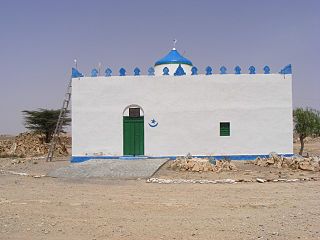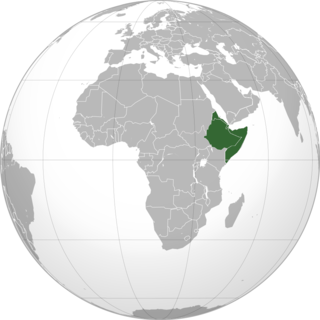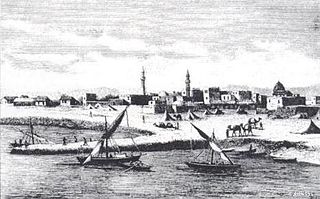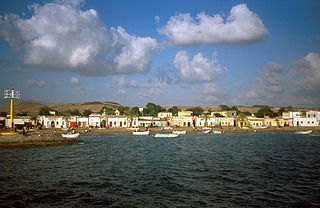
Somalia, officially the Federal Republic of Somalia and formerly known as the Somali Democratic Republic, is a country located in the Horn of Africa.

Italian Somaliland, sometimes also referred to as Italian Somalia, was a colony of the Kingdom of Italy in present-day northeastern, central and southern Somalia. Ruled in the 19th century by the Somali Majeerteen Sultanate and the Sultanate of Hobyo, the territory was later acquired in the 1880s by Italy through various treaties.
The Majeerteen is a Somali clan. It is one of the major Somali clans, with a vast traditional territory spanning 3 major regions of Somalia: Bari, Nugaal and Mudug. From Bosaso down to Garacad, the Majerteen are settled in what is literally considered to be the 'Horn of Africa'. Its members form a part of the Darod clan family, and primarily inhabit the Puntland state of northeastern Somalia.

The Darod is a Somali clan. The forefather of this clan was Abdirahman bin Isma'il al-Jabarti, more commonly known as Darood. The Darod clan is the largest Somali clan in the Horn of Africa, with a wide traditional territory.
The Garhajis is a sub-clan of the Isaaq. They are the traditional holders of the Isaaq Sultanate since the late 18th century. Its members form a part of the Habar Magaadle confederation, and they contstitute the largest sub-clan of the Isaaq. The Garhajis are divided into two major sub-clans, the Habar Yunis and Eidagale. They are traditionally nomadic pastoralists and merchants. One of the earliest mentions of the Garhajis in Western literature was in the Journal of the Royal Geographical Society of London in 1848, where they are described as a powerful and warlike clan.

Hobyo, is an ancient port city in Galmudug state in the north-central Mudug region of Somalia. Hobyo serves as the main port of Galmudug State.
Sultan Olol Dinle (?-1960s) was a Somali sultan who ruled Kelafo as the head of the Ajuran clan. He successively offered allegiance to the Kingdom of Italy in the 1920s and was named "Sultan of Sciavelli (Shabelle)" in the early 1930s.
The following is an index of Somalia-related articles.

The Sultanate of Hobyo, also known as the Sultanate of Obbia, was a 19th-century Somali kingdom in present-day northeastern and central Somalia and eastern Ethiopia. It was established in 1870s by Yusuf Ali Kenadid, cousin of the Majeerteen Sultanate ruler Boqor Osman Mahamuud, after overpowering the local Hawiye clans.
Osman Mahamud (Somali: Cusmaan Maxamuud is a Somali sub-clan. It forms a part of the Majeerteen Harti confederation of Darod clans.
Yusuf Ali Kenadid was a Somali Sultan. He was the founder of the Sultanate of Hobyo in the 1870s. Along with Sultan Mohamoud Ali Shire of the Warsangali Sultanate and King Osman Mahamuud of the Majeerteen Sultanate, Yusuf Ali was one of the three prominent rulers of present-day Somalia at the turn of the 20th century. He was succeeded atop the throne by his son Ali Yusuf Kenadid. The army of Yusuf Ali Kenadid conquered the local Hawiye clan and established Sultanate of Hobyo in 1870s.

The Majeerteen Sultanate, also known as Majeerteenia and Migiurtinia, was a Somali kingdom centered in the Horn of Africa. Ruled by Boqor Osman Mahamuud during its golden age, the sultanate controlled much of northern and central Somalia in the 19th and early 20th centuries. The polity had all of the organs of an integrated modern state and maintained a robust trading network. It also entered into treaties with foreign powers and exerted strong centralized authority on the domestic front. Much of the Sultanate's former domain is today coextensive with the autonomous Puntland region in northeastern Somalia.
Osman Mahamuud, also known as `Uthman III ibn Mahmud, was a Somali king. He led the Majeerteen Sultanate during its Golden Age in the mid-19th to early 20th centuries. Osman Mahmoud. Omar Mahmoud. Isse Mahmoud Real Brothers but they live in different cities and they Boqor.

The military history of Somalia encompasses the major conventional wars, conflicts and skirmishes involving the historic empires, kingdoms and sultanates in the territory of present-day Somalia, through to modern times. It also covers the martial traditions, military architecture and hardware employed by Somali armies and their opponents.

Somali nationalism (Somali:Soomaalinimo) is centered on the notion that the Somali people share a common language, religion, culture and ethnicity, and as such constitute a nation unto themselves. The ideology's earliest manifestations are often traced back to the resistance movement led by Mohammed Abdullah Hassan's Dervish movement at the turn of the 20th century. In northwestern present-day Somalia, the first Somali nationalist political organization to be formed was the Somali National League (SNL), established in 1935 in the former British Somaliland protectorate. In the country's northeastern, central and southern regions, the similarly-oriented Somali Youth Club (SYC) was founded in 1943 in Italian Somaliland, just prior to the trusteeship period. The SYC was later renamed the Somali Youth League (SYL) in 1947. It became the most influential political party in the early years of post-independence Somalia.

This is a list of Somali aristocratic and court titles that were historically used by the Somali people's various sultanates, kingdoms and empires. Also included are the honorifics reserved for Islamic notables as well as traditional leaders and officials within the Somali customary law (xeer), in addition to the nobiliary particles set aside for distinguished individuals.

Italy–Somalia relations are bilateral relations between Italy and Somalia.

Ali Yusuf Kenadid was a Somali ruler. He was the second Sultan of the Sultanate of Hobyo.

The Royal Corps of Somali Colonial Troops was the colonial body of the Royal Italian Army based in Italian Somaliland, in present-day northeastern, central and southern Somalia.

























